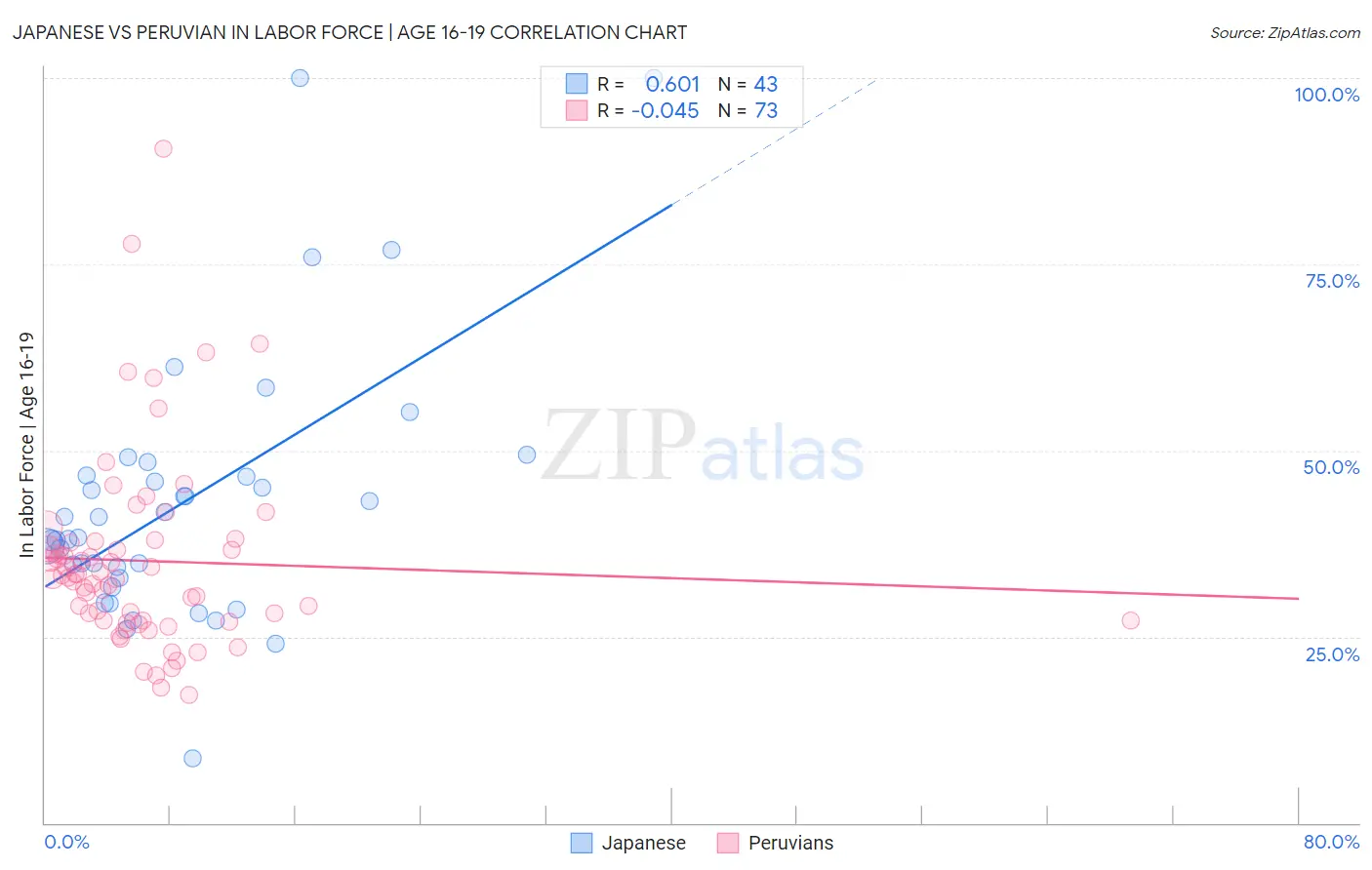Japanese vs Peruvian In Labor Force | Age 16-19
COMPARE
Japanese
Peruvian
In Labor Force | Age 16-19
In Labor Force | Age 16-19 Comparison
Japanese
Peruvians
37.5%
IN LABOR FORCE | AGE 16-19
89.3/ 100
METRIC RATING
144th/ 347
METRIC RANK
34.6%
IN LABOR FORCE | AGE 16-19
1.4/ 100
METRIC RATING
255th/ 347
METRIC RANK
Japanese vs Peruvian In Labor Force | Age 16-19 Correlation Chart
The statistical analysis conducted on geographies consisting of 249,091,187 people shows a significant positive correlation between the proportion of Japanese and labor force participation rate among population between the ages 16 and 19 in the United States with a correlation coefficient (R) of 0.601 and weighted average of 37.5%. Similarly, the statistical analysis conducted on geographies consisting of 362,835,907 people shows no correlation between the proportion of Peruvians and labor force participation rate among population between the ages 16 and 19 in the United States with a correlation coefficient (R) of -0.045 and weighted average of 34.6%, a difference of 8.5%.

In Labor Force | Age 16-19 Correlation Summary
| Measurement | Japanese | Peruvian |
| Minimum | 8.6% | 17.1% |
| Maximum | 100.0% | 90.5% |
| Range | 91.4% | 73.4% |
| Mean | 43.1% | 35.2% |
| Median | 38.2% | 33.0% |
| Interquartile 25% (IQ1) | 32.8% | 27.1% |
| Interquartile 75% (IQ3) | 46.7% | 37.8% |
| Interquartile Range (IQR) | 13.8% | 10.6% |
| Standard Deviation (Sample) | 17.9% | 12.9% |
| Standard Deviation (Population) | 17.7% | 12.8% |
Similar Demographics by In Labor Force | Age 16-19
Demographics Similar to Japanese by In Labor Force | Age 16-19
In terms of in labor force | age 16-19, the demographic groups most similar to Japanese are Paiute (37.5%, a difference of 0.0%), Pakistani (37.6%, a difference of 0.020%), Sierra Leonean (37.6%, a difference of 0.050%), Immigrants from Western Europe (37.5%, a difference of 0.050%), and Brazilian (37.5%, a difference of 0.080%).
| Demographics | Rating | Rank | In Labor Force | Age 16-19 |
| Cajuns | 93.2 /100 | #137 | Exceptional 37.8% |
| Comanche | 91.9 /100 | #138 | Exceptional 37.7% |
| Immigrants | Moldova | 91.9 /100 | #139 | Exceptional 37.7% |
| Estonians | 91.7 /100 | #140 | Exceptional 37.7% |
| Syrians | 90.7 /100 | #141 | Exceptional 37.6% |
| Sierra Leoneans | 89.7 /100 | #142 | Excellent 37.6% |
| Pakistanis | 89.5 /100 | #143 | Excellent 37.6% |
| Japanese | 89.3 /100 | #144 | Excellent 37.5% |
| Paiute | 89.3 /100 | #145 | Excellent 37.5% |
| Immigrants | Western Europe | 88.9 /100 | #146 | Excellent 37.5% |
| Brazilians | 88.7 /100 | #147 | Excellent 37.5% |
| Romanians | 87.3 /100 | #148 | Excellent 37.5% |
| Native Hawaiians | 85.0 /100 | #149 | Excellent 37.4% |
| Tsimshian | 84.7 /100 | #150 | Excellent 37.4% |
| Immigrants | Poland | 84.4 /100 | #151 | Excellent 37.3% |
Demographics Similar to Peruvians by In Labor Force | Age 16-19
In terms of in labor force | age 16-19, the demographic groups most similar to Peruvians are Bahamian (34.6%, a difference of 0.040%), Immigrants from South Central Asia (34.6%, a difference of 0.11%), Immigrants from Egypt (34.6%, a difference of 0.11%), Thai (34.6%, a difference of 0.12%), and Immigrants (34.6%, a difference of 0.13%).
| Demographics | Rating | Rank | In Labor Force | Age 16-19 |
| Central Americans | 2.2 /100 | #248 | Tragic 34.8% |
| Immigrants | Ukraine | 2.2 /100 | #249 | Tragic 34.8% |
| Immigrants | Pakistan | 2.0 /100 | #250 | Tragic 34.8% |
| Immigrants | Western Asia | 2.0 /100 | #251 | Tragic 34.8% |
| Immigrants | Chile | 2.0 /100 | #252 | Tragic 34.8% |
| Immigrants | Japan | 1.5 /100 | #253 | Tragic 34.7% |
| Bahamians | 1.4 /100 | #254 | Tragic 34.6% |
| Peruvians | 1.4 /100 | #255 | Tragic 34.6% |
| Immigrants | South Central Asia | 1.3 /100 | #256 | Tragic 34.6% |
| Immigrants | Egypt | 1.2 /100 | #257 | Tragic 34.6% |
| Thais | 1.2 /100 | #258 | Tragic 34.6% |
| Immigrants | Immigrants | 1.2 /100 | #259 | Tragic 34.6% |
| Egyptians | 1.2 /100 | #260 | Tragic 34.5% |
| Salvadorans | 1.1 /100 | #261 | Tragic 34.5% |
| Hispanics or Latinos | 1.1 /100 | #262 | Tragic 34.5% |